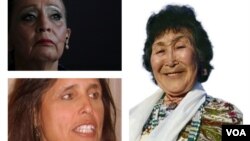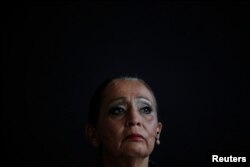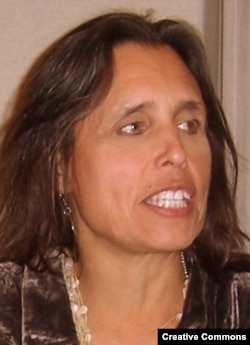Editor’s note:
November is Native American Heritage Month. First proclaimed by President George H. W. Bush in 1990, it is an opportunity to acknowledge the histories and cultures of Native people across the U.S., highlighting the challenges they have faced, their sacrifices and their contributions.
“Native Americans have influenced every stage of America's development,” noted President Donald Trump in his October 31, 2017 proclamation. “They helped early European settlers survive and thrive in a new land. They contributed democratic ideas to our constitutional framers. And, for more than 200 years, they have bravely answered the call to defend our Nation, serving with distinction in every branch of the United States Armed Forces.”
This month, VOA will highlight prominent Native Americans and their role in U.S. history, culture and society.
Native American women across the United States have gained prominence in the fight for peace, justice and the environment. Here are three you should know about:
LaDonna Brave Bull Allard (Lakota/Dakota)
“I am nothing more than a mother and a grandmother.’” May 24, 2017
LaDonna Brave Bull Allard is an activist and former Standing Rock Sioux tribal historic preservation officer who emerged as a leader in the 2016 Dakota Access Pipeline protests. When the Dallas-based Energy Transfer Partners (ETP) decided to re-route a segment of an oil pipeline beneath the Missouri River at the top of Lake Oahe in North Dakota, Allard feared that the tribe’s historic sites and water supply were at risk. In April 2016, she founded the Sacred Stone Camp, the first camp of the #NoDAPL movement, which brought in thousands of protesters from tribes across the country as well as international supporters. Before the protests were over, they would have endured attack dogs, percussion grenades, tear gas, rubber bullets and fire hoses.
Authorities ultimately forced the camps to close in late 2016, and by early February 2017, ETP began constructing the pipeline beneath Lake Oahe. Allard and fellow Native activists have taken their campaign across the globe, calling on international banks to divest from fossil fuel companies that violate Indigenous peoples’ rights.
Winona LaDuke (Anishinaabe)
“I consider myself a patriot -- not to a flag -- to a land.” Acceptance speech to Green Party, July 22, 2000.
Winona LaDuke was a 19-year-old Harvard University student when she attended the 1977 UN Indigenous Peoples Conference in Geneva and testified first-hand about the harmful impact of natural resources exploitation on Native Americans. She has since dedicated her life to fighting climate change and protecting the land through culturally-based sustainable development and renewable energy programs.
A member of the Anishinaabe (Ojibwe) Nation, she lives on the White Earth reservation in north-central Minnesota. There, in 1989, she founded the White Earth Land Recovery Project, which works to restore the Anishinaabe’s original land base and to preserve the Anishinaabe language, culture and traditional food systems.
As Program Director of Honor the Earth, she works nationally and internationally on issues of climate change, alternative energy, and environmental justice with indigenous communities. She is also an author of several books and has received numerous awards. In 2007, LaDuke was inducted into the National Women’s Hall of Fame.
Rita Pitka-Blumenstein (Yup’ik)
“We create our lives out of our past and out of the present…We are our ancestors when we heal ourselves. When we heal ourselves, we also heal Mother Earth and we heal all future generations.” Quoted in Carol Schaeffer, Grandmothers Counsel the World.
The first certified traditional doctor in the state of Alaska, Rita Pitka-Blumenstein was born in 1936 on a fishing boat on Nelson Island, a member of the Yup’ik, or “Real People.” Her father died shortly after she was born, and she was raised by women--grandmothers and great-grandmothers in the fishing village of Tununak. The women in her life taught her traditional healing methods which had survived, despite church and U.S. government efforts to outlaw them. She later brought these methods to work with her as a community health aide.
In 1997, Pitka-Blumenstein became the first tribal doctor at Anchorage’s Southcentral Foundation, a Native-owned, non-profit health care organization serving nearly 65,000 Native people. There, she worked to ensure that traditional healing complemented Western practices, both seeing patients and advising medical staff.
In 2004, Pitka-Blumenstein joined 12 other women on the International Council of 13 Grandmothers, a global alliance of indigenous elder women working to preserve traditional knowledge, heal the environment and promote global solidarity.














